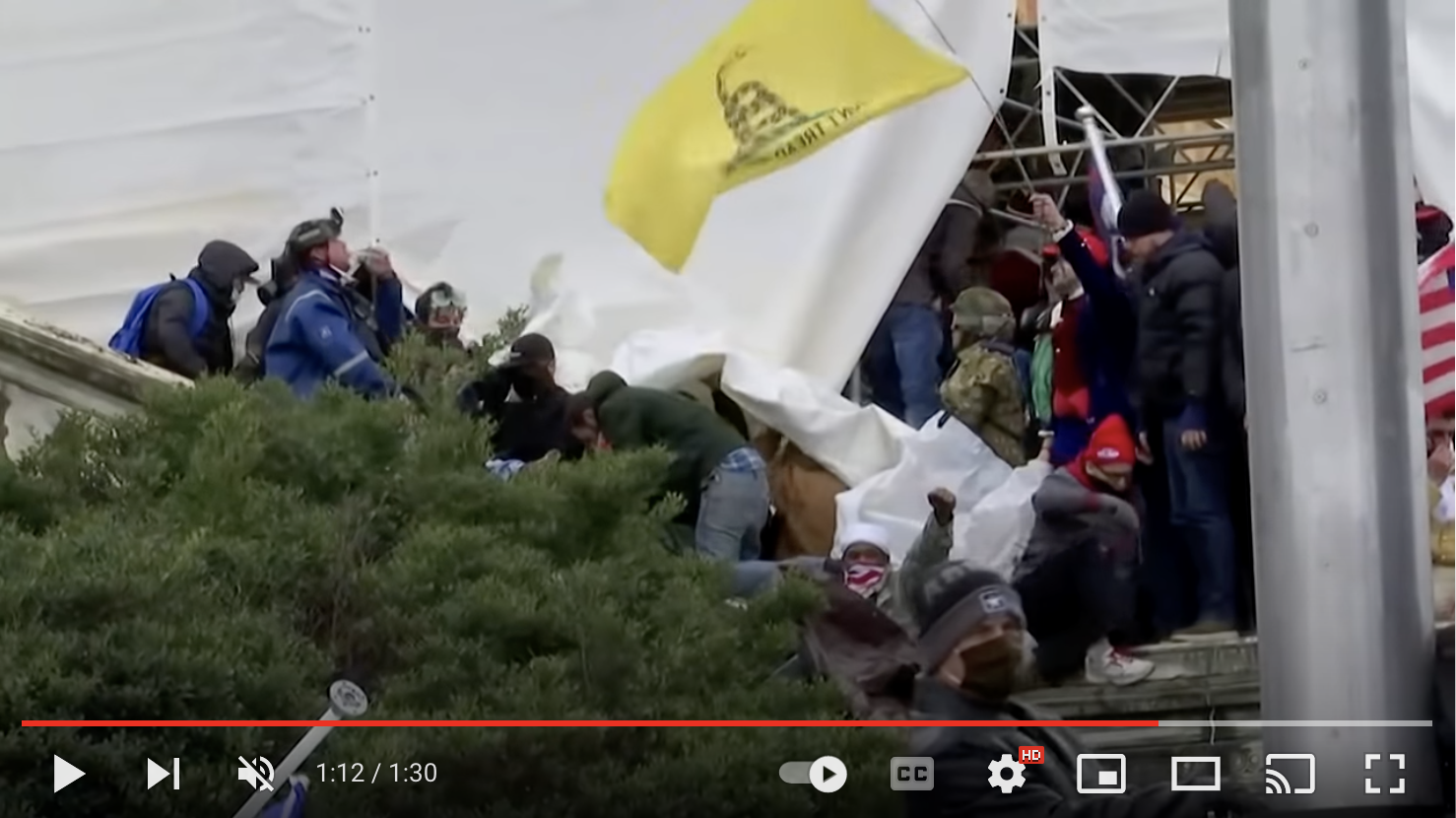The First Trial of a Capitol Riot Defendant: A Shock-and-Awe Campaign of Video, Audio, and Other Digital Evidence
When Capitol riot defendant Guy Reffitt goes to trial before a federal jury in Washington, D.C., prosecutors plan to present a shock-and-awe campaign of video, audio and other digital evidence.

Published by The Lawfare Institute
in Cooperation With

“The revolution will not be televised,” Gil Scott Heron said. Well, maybe not. But the Jan. 6 insurrection sure was.
On Monday, when Capitol riot defendant Guy Reffitt, of Wylie, Texas, goes to trial before a federal jury in Washington, D.C., prosecutors plan to present a shock-and-awe campaign of video, audio, and other digital evidence. Reffitt is the first of the more than 750 Capitol siege defendants to put the government to its proof. About 215 defendants have already pleaded guilty.
Reffitt, 49, faces five felony charges, two of which carry maximum terms of up to 20 years in prison. He has been incarcerated since his arrest on Jan. 19, 2021. Judge Dabney Friedrich of the U.S. District Court for the District of Columbia will preside over his trial.
To mount their case, prosecutors plan to show the jurors, among other things, an array of video clips displaying the defendant’s allegedly criminal conduct on the Capitol’s West Terrace that day, according to their exhibit and witness lists. Those videos were shot by Reuters; by Fox News; by an outfit called News2Share; by a freelance journalist named Emily Molli; by the holder of a smartphone whom the prosecution hasn’t yet identified; and by at least four closed-circuit surveillance cameras maintained by the U.S. Capitol Police on Capitol grounds.
On top of that, prosecutors, led by assistant U.S. attorneys Jeffrey Nestler and Risa Berkower, expect to show excerpts from 48 minutes of MP4 footage that the defendant himself generated from a Kodak Orbit 360 videocamera he wore on his helmet. When these files are loaded into an appropriate player, images can be panned and rotated 360 degrees at the viewers’ will.
And that’s just the start. As I’ll detail below, prosecutors plan to use many additional audio, video, and text files capturing Reffitt’s actions and words.
Yet while Reffitt’s case might be extreme in terms of the quantity of evidence prosecutors are martialing against him, his situation is not qualitatively different from that of others accused in connection with the Capitol insurrection. Many face crushing digital chronicles of what they did that day. The Capitol’s halls and grounds are surveilled, 24/7, by 515 closed-circuit cameras. At least 675 of the Metropolitan Police Department officers who arrived to shore up the U.S. Capitol Police that day wore cameras on their persons, as did another 54 officers from the Arlington Co. (Virginia) Police Department. Given the singular importance of the specific congressional proceeding that the rioters were disrupting—the counting of the Electoral College vote and the peaceful transfer of power—media cameras were ubiquitous, as were those of freelancers and bystanders. With Vice President Pence on hand, U.S. Secret Service cameras were also capturing aspects of the event. Finally, given the rioters’ pride in what they were doing—answering the call of their president—a large percentage were generating their own incriminating videos and stills while boasting of their exploits in texts, message apps, emails, and social media posts. According to the George Washington University Project on Extremism, 77 percent of those criminally charged in the siege were arrested at least in part based on evidence obtained from social media.
The allegations against Reffitt are typical of Capitol riot cases in some respects, but atypical in others. The most strikingly atypical aspect is that he is one of the very few who allegedly brought a firearm onto the Capitol grounds—a loaded .40 caliber Smith & Wesson pistol. (The District of Columbia has very strict gun laws, which most rioters appear to have heeded.)
The top count Reffitt faces is one that nearly 40 percent of all Capitol riot defendants also face: corruptly obstructing an official proceeding (18 U.S.C. §1512(c)(2)), which carries a maximum penalty of 20 years. Like about 30 percent of the Jan. 6 defendants, the government also alleged that he skirmished with law enforcement officers. Though prosecutors have not charged him with “assaulting” officers (a more serious charge many Capitol rioters face), he is accused of “impeding” two of them during a “civil disorder” (18 U.S.C. §231(a)(3)), which carries a maximum five-year term.
In a nutshell, prosecutors allege the following, as they’ve put it in filings seeking to keep Reffitt detained prior to trial, and at a detention hearing. Reffitt was “at the front of the first group of rioters to challenge a police line” on the Capitol’s West Terrace that day. He arrived at 1:50 pm, about twenty minutes before the first breach of the Capitol building. (Prosecutors will prove his movements and their timing using data from the Life360 app Reffitt had running on his phone at the time—an app that alerts family members to one’s whereabouts. Reffitt’s app was running steadily from Jan. 4 through Jan. 13.) “A leader” of the Texas Three Percenters militia group, Reffitt wore a helmet and body armor that day, and carried plastic zip tie flex cuffs in addition to his holstered gun. While a group of about 50 rioters gathered on a landing, “the defendant, alone, advanced higher up the stairs directly towards [three] officers.” The officers fended him off with an escalating series of non-lethal weapons: pepperballs; projectiles shot from a pellet gun; and two cannisters of pepper spray (oleoresin capsicum)—the second of which finally succeeded in repelling his attack. But, the prosecutors allege, while the officers
were preoccupied with stopping the defendant’s advances, other rioters started ascending elsewhere, quickly overwhelming the police line. And another man, who seemed to have been instigated by the defendant’s actions, and who was wearing a gas mask, charged forward from the crowd and physically attacked . . . two USCP officers who had already been engaged with this defendant.
While Reffitt did not penetrate the Capitol building, his alleged presence on the steps (a “restricted area”) that day would still constitute a crime. Though it would ordinarily be a misdemeanor—one with which 90 percent of the Capitol rioters have been charged—his alleged possession of a firearm bumps the offense up to a felony with a maximum 10-year sentence.
Finally, prosecutors have charged Reffitt with two additional felonies, each of which is unusual among Capitol riot defendants. The first is transporting a firearm to a civil disorder (18 U.S.C. §231(a)(2)), which carries a 5-year maximum term. That charge relates not just to the pistol, but also to an AR 15 rifle that Reffitt allegedly took with him on the drive from Wylie (near Dallas) to the Melrose Georgetown Hotel in Washington, where he stayed.
The final count alleges a second form of obstruction of justice (18 U.S.C. §1512(a)(2)(C))—another 20-year-maximum felony. It stems from the allegation that when Reffitt got back to his home in Texas, he began to realize that his then 16-year-old daughter, Peyton, and 18-year-old son, Jackson, were not thrilled with what he’d done. Seeing Peyton touching her smartphone keypad, Reffitt allegedly told her that if she was recording him he’d “put a bullet through that phone.” He then told Peyton and Jackson to “choose a side or die,” and explained that informants were traitors and that “traitors get shot,” the government charges.
Peyton, who appeared as a witness for Reffitt last March at a pretrial detention hearing, testified that she never feared her father would really harm her. She did admit, however, that she thought he was trying to “intimidate” her “not to pursue” the matter. Peyton, her older sister, Sarah, and Reffitt’s wife, Jody Nicole, have all rallied to Reffitt’s defense in the media. In an article in Vice News, for instance, the three are pictured posing in orange T-shirts monogrammed:
POLITICAL PRISONER
376782
#FREEGUYREFFITT.
The son, Jackson, is a different story. Jackson first reported his father to the FBI in December 2020—before the insurrection. He had become alarmed by Reffitt’s comments about “doing some serious damage” relating to “legislators,” according to prosecutors. (It’s not known what, if anything, the FBI did with Jackson’s pre-attack warning, though it may have been too vague to act upon.)
Sometime after Reffitt returned from Washington on Jan. 8, his son, Jackson, began using his cell phone to covertly record his father’s admissions about what he’d done. Prosecutors plan to play five excerpts from these for the jury, according to their exhibit and witness lists. On or about Jan. 16—when the FBI executed search warrants on Reffitt’s home, car, phone, computers, and hard drives—Jackson “relocated from his family’s home to an undisclosed location,” according to the government. (Since then, Jackson, too, has made media appearances, beginning with an interview with CNN’s Chris Cuomo on Jan. 22, 2021. In those, he has expressed love for his father, but unalloyed disapproval of his conduct. He is listed as a prosecution witness.)
Before Reffitt’s arrest on Jan. 19, he generated one last piece of digital evidence that prosecutors plan to use against him. On the night of Jan. 9, he taped a 1-hour-and-43-minute Zoom meeting with two other Three Percenters. The government plans to present portions of that conference call, too. Reffitt admitted then, for instance, having “had my Spartan armor plates, my kidney plates, and my .40 on my side.” Then, in reference to a conversation he’d had at the Ellipse before heading to the Capitol, he recounted: “I said, ‘Well I’m not done till we drag them out screaming and kicking. I don’t care if Pelosi’s head is hitting every step while I drag her by her ankles – she’s coming out.’”
On that recording, he also described his interactions with one of the Capitol Police officers on the Capitol steps:
So then I stepped forward and she started pelting my bulletproof armor with clay balls, and they were just going, pop pop pop. And . . . I looked at her and said, “Sorry, darling. You better get a bigger damn gun.”
. . .
I was almost close enough to dive for her and take the gun away from her when a man come around the corner with bear spray. . . .
When everybody saw me get bear sprayed and shot, and go down on the bannister rail, it was a full onslaught move forward. No one stopped from that moment on . . . .
Nobody was moving forward until I climbed up that bannister . . . .
Later in the Zoom meeting, Reffitt allegedly discussed future criminal activity, including attacks he wanted to stage against the “mainstream media,” “Silicon Valley,” and “Big Tech.”
“Specifically,” the government alleges, “he described a prominent social media company’s facility in a nearby Texas town and how its backup generators could be disabled with properly placed gunshots from a sniper’s rifle.”
The government will argue that his threats to commit future crimes were not idle. For instance, prosecutors intend to prove (though, as yet, it’s unclear how) that, even after the insurrection, Reffitt “recruited other rioters into the militia, and ordered bear spray and riot shields to his home to prepare for further violence.”
When the FBI searched Reffitt’s phone on Jan. 16, 2021, it gained access to a number of text conversations with friends and associates using SMS and the Telegram message app. The government plans to show the jury nine of these threads, from both before and after the attack.
In one from Dec. 28, 2020, for instance—a week before the attack—Reffitt allegedly wrote:
I don’t think unarmed will be the case this time. I will be in full battle rattle. If that’s a law I break, so be it but I won’t do it alone. They spent four years breaking the laws. The government has spent decades committing treason. I’m not afraid of unconstitutional laws.
On Jan. 13, 2021—a week after the attack—he allegedly sent this one:
We took the Capital and put the POS Capital Hill on it’s heels. This has only just begun and will not end until we The People of The Republic have won our country back. We had thousands of weapons and fired no rounds yet showed numbers. The next time we will not be so cordial.
That Reffitt is the first Capitol riot defendant to go to trial appears to be largely happenstance. Prosecutors have limited control over who chooses to plead guilty and who doesn’t, and each judge sets the date of each trial according to the vagaries of his or her calendar.
It’s hard to believe prosecutors aren’t pleased with the luck of the draw here, though, given both the seriousness of the accusations against Reffitt and the wealth of evidence.
Still, they are obviously taking no chances. In addition to all the evidence already outlined—and the anticipated testimony of, among others, the three police officers he confronted that day—prosecutors have immunized one of Reffitt’s fellow militia members, described in court filings only as R.H. He rode with Reffitt from Wylie to D.C. and back. They plan to call him to describe the weapons Reffitt brought, Reffitt’s tactical gear, and their conversations, including one in which Reffitt “talked about ‘dragging those people out of the Capitol by their ankles’ and installing a new government.”
Reffitt’s counsel, William L. Welch of Columbia, Maryland, did not respond to an inquiry seeking comment on Saturday. Welch is a former assistant public defender in Baltimore who has almost 30 years experience in criminal defense.
This past January, however, ABC News did manage to interview Reffitt himself briefly by phone. He expressed confidence about his upcoming trial.
"It's not that hard to prove that I didn't do anything," Reffitt told ABC then. "Should be pretty easy."





